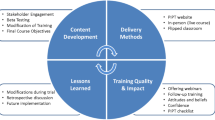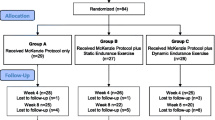Abstract
The general population has a pessimistic view of low back pain (LBP), and evidence-based information has been used to positively influence LBP beliefs in previously reported mass media studies. However, there is a lack of randomized trials investigating whether LBP beliefs can be modified in primary prevention settings. This cluster randomized clinical trial investigated the effect of an evidence-based psychosocial educational program (PSEP) on LBP beliefs for soldiers completing military training. A military setting was selected for this clinical trial, because LBP is a common cause of soldier disability. Companies of soldiers (n = 3,792) were recruited, and cluster randomized to receive a PSEP or no education (control group, CG). The PSEP consisted of an interactive seminar, and soldiers were issued the Back Book for reference material. The primary outcome measure was the back beliefs questionnaire (BBQ), which assesses inevitable consequences of and ability to cope with LBP. The BBQ was administered before randomization and 12 weeks later. A linear mixed model was fitted for the BBQ at the 12-week follow-up, and a generalized linear mixed model was fitted for the dichotomous outcomes on BBQ change of greater than two points. Sensitivity analyses were performed to account for drop out. BBQ scores (potential range: 9–45) improved significantly from baseline of 25.6 ± 5.7 (mean ± SD) to 26.9 ± 6.2 for those receiving the PSEP, while there was a significant decline from 26.1 ± 5.7 to 25.6 ± 6.0 for those in the CG. The adjusted mean BBQ score at follow-up for those receiving the PSEP was 1.49 points higher than those in the CG (P < 0.0001). The adjusted odds ratio of BBQ improvement of greater than two points for those receiving the PSEP was 1.51 (95% CI = 1.22–1.86) times that of those in the CG. BBQ improvement was also mildly associated with race and college education. Sensitivity analyses suggested minimal influence of drop out. In conclusion, soldiers that received the PSEP had an improvement in their beliefs related to the inevitable consequences of and ability to cope with LBP. This is the first randomized trial to show positive influence on LBP beliefs in a primary prevention setting, and these findings have potentially important public health implications for prevention of LBP.


Similar content being viewed by others
References
Albaret MC, Munoz Sastre MT, Cottencin A, Mullet E (2004) The Fear of Pain questionnaire: factor structure in samples of young, middle-aged and elderly European people. Eur J Pain 8(3):273–281. doi:10.1016/j.ejpain.2003.09.005
Andersson HI, Ejlertsson G, Leden I, Rosenberg C (1993) Chronic pain in a geographically defined general population: studies of differences in age, gender, social class, and pain localization. Clin J Pain 9(3):174–182. doi:10.1097/00002508-199309000-00004
Asche CV, Kirkness CS, dam-Marx C, Fritz JM (2007) The societal costs of low back pain: data published between 2001 and 2007. J Pain Palliat Care Pharmacother 21(4):25–33
Benson K, Hartz AJ (2000) A comparison of observational studies and randomized, controlled trials. N Engl J Med 342(25):1878–1886. doi:10.1056/NEJM200006223422506
Buchbinder R, Jolley D (2005) Effects of a media campaign on back beliefs is sustained 3 years after its cessation. Spine 30(11):1323–1330. doi:10.1097/01.brs.0000164121.77862.4b
Buchbinder R, Jolley D, Wyatt M (2001) 2001 Volvo award winner in clinical studies: effects of a media campaign on back pain beliefs and its potential influence on management of low back pain in general practice. Spine 26(23):2535–2542. doi:10.1097/00007632-200112010-00005
Buchbinder R, Jolley D, Wyatt M (2001) Population based intervention to change back pain beliefs and disability: three part evaluation. BMJ 322(7301):1516–1520. doi:10.1136/bmj.322.7301.1516
Burton AK, Waddell G, Tillotson KM, Summerton N (1999) Information and advice to patients with back pain can have a positive effect. A randomized controlled trial of a novel educational booklet in primary care. Spine 24(23):2484–2491. doi:10.1097/00007632-199912010-00010
Chibnall JT, Tait RC (1994) The short form of the Beck Depression Inventory: validity issues with chronic pain patients. Clin J Pain 10(4):261–266. doi:10.1097/00002508-199412000-00004
Coudeyre E, Tubach F, Rannou F, Baron G, Coriat F, Brin S, Revel M, Poiraudeau S (2007) Effect of a simple information booklet on pain persistence after an acute episode of low back pain: a non-randomized trial in a primary care setting. PLoS ONE 2(1):e706. doi:10.1371/journal.pone.0000706
George SZ, Childs JD, Teyhen DS, Wu SS, Wright AC, Dugan JL, Robinson ME (2007) Rationale, design, and protocol for the prevention of low back pain in the military (POLM) trial (NCT00373009). BMC Musculoskelet Disord 8:92. doi:10.1186/1471-2474-8-92
George SZ, Fritz JM, Bialosky JE, Donald DA (2003) The effect of a fear-avoidance-based physical therapy intervention for patients with acute low back pain: results of a randomized clinical trial. Spine 28(23):2551–2560. doi:10.1097/01.BRS.0000096677.84605.A2
Gross DP, Ferrari R, Russell AS, Battie MC, Schopflocher D, Hu RW, Waddell G, Buchbinder R (2006) A population-based survey of back pain beliefs in Canada. Spine 31(18):2142–2145. doi:10.1097/01.brs.0000231771.14965.e4
Indahl A, Haldorsen EH, Holm S, Reikeras O, Ursin H (1998) Five-year follow-up study of a controlled clinical trial using light mobilization and an informative approach to low back pain. Spine 23(23):2625–2630. doi:10.1097/00007632-199812010-00018
Indahl A, Velund L, Reikeraas O (1995) Good prognosis for low back pain when left untampered. A randomized clinical trial. Spine 20(4):473–477. doi:10.1097/00007632-199512150-00006
Lincoln AE, Smith GS, Amoroso PJ, Bell NS (2002) The natural history and risk factors of musculoskeletal conditions resulting in disability among US Army personnel. Work 18(2):99–113
Linton SJ (2000) A review of psychological risk factors in back and neck pain. Spine 25(9):1148–1156. doi:10.1097/00007632-200005010-00017
Malmivaara A, Hakkinen U, Aro T, Heinrichs ML, Koskenniemi L, Kuosma E, Lappi S, Paloheimo R, Servo C, Vaaranen V (1995) The treatment of acute low back pain—bed rest, exercises, or ordinary activity? N Engl J Med 332(6):351–355. doi:10.1056/NEJM199502093320602
Mantyselka P, Kumpusalo E, Ahonen R, Kumpusalo A, Kauhanen J, Viinamaki H, Halonen P, Takala J (2001) Pain as a reason to visit the doctor: a study in Finnish primary health care. Pain 89(2–3):175–180. doi:10.1016/S0304-3959(00)00361-4
Martin BI, Deyo RA, Mirza SK, Turner JA, Comstock BA, Hollingworth W, Sullivan SD (2008) Expenditures and health status among adults with back and neck problems. JAMA 299(6):656–664. doi:10.1001/jama.299.6.656
McNeil DW, Rainwater AJ (1998) Development of the Fear of Pain Questionnaire–III. J Behav Med 21(4):389–410. doi:10.1023/A:1018782831217
Moher D, Schulz KF, Altman DG (2001) The CONSORT statement: revised recommendations for improving the quality of reports of parallel-group randomized trials. J Am Podiatr Med Assoc 91(8):437–442
Olsen OE, Myklebust G, Engebretsen L, Holme I, Bahr R (2005) Exercises to prevent lower limb injuries in youth sports: cluster randomised controlled trial. BMJ 330(7489):449. doi:10.1136/bmj.38330.632801.8F
Ornstein S, Jenkins RG, Nietert PJ, Feifer C, Roylance LF, Nemeth L, Corley S, Dickerson L, Bradford WD, Litvin C (2004) A multimethod quality improvement intervention to improve preventive cardiovascular care: a cluster randomized trial. Ann Intern Med 141(7):523–532
Osman A, Breitenstein JL, Barrios FX, Gutierrez PM, Kopper BA (2002) The Fear of Pain Questionnaire-III: further reliability and validity with nonclinical samples. J Behav Med 25(2):155–173. doi:10.1023/A:1014884704974
Pincus T, Burton AK, Vogel S, Field AP (2002) A systematic review of psychological factors as predictors of chronicity/disability in prospective cohorts of low back pain. Spine 27(5):E109–E120. doi:10.1097/00007632-200203010-00017
Roland M, Waddell G, Klaber-Moffett J (1996) The Back Book, 1996. The Stationery Office, Norwich, United Kingdom
Schotte CK, Maes M, Cluydts R, De Doncker D, Cosyns P (1997) Construct validity of the Beck Depression Inventory in a depressive population. J Affect Disord 46(2):115–125. doi:10.1016/S0165-0327(97)00094-3
Songer TJ, LaPorte RE (2000) Disabilities due to injury in the military. Am J Prev Med 18(3)(Suppl):33–40. doi:10.1016/S0749-3797(00)00107-0
Spielberger CD, Gorsuch RL, Lushene RE, Vagg PR, Jacobs GA (1993) Manual for the state and trait anxiety inventory (form Y). Consulting Psychologists Press, Palo Alto, CA
Stang P, Von Korff M, Galer BS (1998) Reduced labor force participation among primary care patients with headache. J Gen Intern Med 13(5):296–302. doi:10.1046/j.1525-1497.1998.00094.x
Sternbach RA (1986) Pain and ‘hassles’ in the United States: findings of the Nuprin pain report. Pain 27(1):69–80. doi:10.1016/0304-3959(86)90224-1
Stewart WF, Ricci JA, Chee E, Morganstein D, Lipton R (2003) Lost productive time and cost due to common pain conditions in the US workforce. JAMA 290(18):2443–2454. doi:10.1001/jama.290.18.2443
Symonds TL, Burton AK, Tillotson KM, Main CJ (1995) Absence resulting from low back trouble can be reduced by psychosocial intervention at the work place. Spine 20(24):2738–2745. doi:10.1097/00007632-199512150-00016
Symonds TL, Burton AK, Tillotson KM, Main CJ (1995) Do attitudes and beliefs influence work loss due to low back trouble? Occup Med (Lond) 46(1):25–32
Vlaeyen JW, Linton SJ (2000) Fear-avoidance and its consequences in chronic musculoskeletal pain: a state of the art. Pain 85(3):317–332. doi:10.1016/S0304-3959(99)00242-0
Waddell G (1987) 1987 Volvo award in clinical sciences. A new clinical model for the treatment of low-back pain. Spine 12(7):632–644. doi:10.1097/00007632-198709000-00002
Waddell G (1996) Low back pain: a twentieth century health care enigma. Spine 21(24):2820–2825. doi:10.1097/00007632-199612150-00002
Waddell G, O’Connor M, Boorman S, Torsney B (2007) Working Backs Scotland: a public and professional health education campaign for back pain. Spine 32(19):2139–2143. doi:10.1097/BRS.0b013e31814541bc
Walker BF, Muller R, Grant WD (2004) Low back pain in Australian adults: prevalence and associated disability. J Manipulative Physiol Ther 27(4):238–244. doi:10.1016/j.jmpt.2004.02.002
Ware J Jr, Kosinski M, Keller SD (1996) A 12-Item Short-Form Health Survey: construction of scales and preliminary tests of reliability and validity. Med Care 34(3):220–233. doi:10.1097/00005650-199603000-00003
Watson L, Small R, Brown S, Dawson W, Lumley J (2004) Mounting a community-randomized trial: sample size, matching, selection, and randomization issues in PRISM. Control Clin Trials 25(3):235–250. doi:10.1016/j.cct.2003.12.002
Werner EL, Ihlebaek C, Laerum E, Wormgoor ME, Indahl A (2008) Low back pain media campaign: no effect on sickness behaviour. Patient Educ Couns 71(2):198–203. doi:10.1016/j.pec.2007.12.009
Whisman MA, Perez JE, Ramel W (2000) Factor structure of the Beck Depression Inventory-Second Edition (BDI-II) in a student sample. J Clin Psychol 56(4):545–551. doi:10.1002/(SICI)1097-4679(200004)56:4<545::AID-JCLP7>3.0.CO;2-U
Acknowledgments
SZG, JDC, DST, SSW, ACW, JLD, and MER were supported by the peer-review medical research program of the Department of Defense (PR054098). Christopher Barnes, Erik Henrikson, and Yang Li were responsible for the creation and management of the database. Donna Cunningham provided administrative assistance during this phase of the study. The institutional review boards at the Brooke Army Medical Center (Fort Sam Houston, Texas) and the University of Florida (Gainesville, FL) granted approval for this project.
Author information
Authors and Affiliations
Corresponding author
Rights and permissions
About this article
Cite this article
George, S.Z., Teyhen, D.S., Wu, S.S. et al. Psychosocial education improves low back pain beliefs: results from a cluster randomized clinical trial (NCT00373009) in a primary prevention setting. Eur Spine J 18, 1050–1058 (2009). https://doi.org/10.1007/s00586-009-1016-7
Received:
Revised:
Accepted:
Published:
Issue Date:
DOI: https://doi.org/10.1007/s00586-009-1016-7




